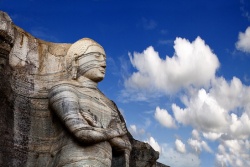Himavā
Himavā, Himācala, Himavanta, etc.
The name given to the Himālaya. It is one of the seven mountain ranges surrounding Gandhamādana (SNA.i.66).
It is three hundred thousand leagues in extent (SNA.i.224), with eighty four thousand peaks its highest peak being five hundred yojanas (SNA.ii.443) In Himavā, are seven great lakes, each fifty leagues in length, breadth and depth - Anotatta, Kannamunda, Rathakāra, Chaddanta, Kunāla, Mandākinī and Sīhappapātaka; these lakes are never heated by the sun (A.iv.101; SNA.ii.407; cf. AA.ii.759). From Himavā flow five hundred rivers. SNA.ii.437; but according to Mil.114, only ten of these are to be reckoned, the others flowing only intermittently. These ten are: Gangā, Yamunā, Aciravatī, Sarabhū, Mahī, Sindhu, Sarassatī, Vettavatī, Vītamsā and Candabhāgā.
In numerous Jātakas Himavā is mentioned as the place to which ascetics retire when they leave household life. It is full of woodlands and groves, suitable for hermits (E.g., SA.i.265). In Himavā is a peak named Mahāpapāta where Pacceka Buddhas die (SNA.i.129). Nāgas go to Himavā to give birth to their young (SA.iii.120; cf. S.v.63). The mountain is often used in similes; it is then referred to as pabbatarājā (E.g., S.ii.137; v.464; A.iii.311; M.iii.166, etc.). Sīvalī Thera once went there from Sāvatthi with five hundred others. The journey took them eight days. (Details are given at ThagA.ii.138; PSA.252).
The country round Himavā was converted by Majjhima Thera (Mhv.xii.41). He was accompanied by four others: Kassapagotta, Mūladeva (Alakadeva), Sahadeva and Dundubhissara (Dpv.viii.10; MT.317). Majjhima preached the Damma-cakka-ppavattana Sutta and eighty crores attained salvation. These five Theras converted five kingdoms and each ordained one hundred thousand persons (Mhv.xii.42f).
Devas brought for Asoka's use, from the Himālaya, twigs of the nāgalatā to clean his teeth, healthful fruits, myrobalan, teminalia and mango fruit (Mhv.v.25f), while, for the foundation of the Mahā Thūpa, sāmaneras with iddhi-power brought sweet scented marumba (Mhv.xxix.9).
The Kunāla Jātaka (q.v.) was preached in the region of Himavā. The Buddha took the Sākyan princes there and showed them the various features, including many mountain peaks, such as: Manipabbata, Hingulapabbata, Añjanapabbata, Sānupabbata, and Phalikapabbata (J.v.415).
On fast days the gods assemble in Himavā and hold discourses. Sp.iv.759.
